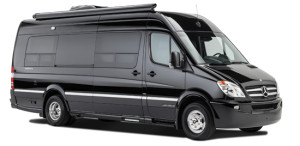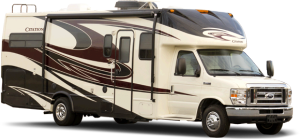Motorhome Classes: Do You Know Your ABCs?
Whether you’re in the market for a new motorhome right now, or you’re just doing some preliminary research, the most vital thing to understand is motorhome classes. There are three primary motorhome classes, and each comes with its own upsides, downsides, quirks, and other little things that every current (or prospective) owner needs to know, but it’s really no more complicated than the ABCs. Literally, the three motorhome classes are A, B, and C. (The potentially confusing bit for newbies is that, ranked in order of size, class A rigs are the biggest, then class C, and finally class B rigs are often no bigger than the vans that they are based on.)
The Differences Between Motorhome Classes
The primary difference between the different classes of motorhomes is the platform that each “family” is built on. The smallest motorized RVs, class B motorhomes, are built on complete van chassis. That means that class B motorhome manufacturers buy complete vans from companies like Ford and Mercedes, strip the interiors, and then turn them into motorhomes. In some cases, they will also modify the body panels, raise the roof, lower the floor, or perform other modifications.

Some class B motorhomes, like Airstream’s current linup, look like regular vans on the outside. Others are modified more substantially.
From there, the next step up is the class C. Like class B motorhomes, class C rigs are typically built on van chassis (although some are built on truck chassis.) Unlike class B rigs, class C motorhomes are built on cutaway chassis. These cutaway van or truck chassis are delivered from the factory with a complete cab (including seats, instrument cluster, steering wheel, etc), but nothing behind the cab. When the motorhome manufacturer receives the chassis, they build the living space of a motorhome on the chassis behind the cab, and typically also include a cabover bunk.
While both B and C motorhome classes are built on passenger truck and van chassis, class A motorhomes are built on either commercial truck chassis or specially designed heavy duty chassis. Some common platforms include Ford’s Superduty F53, Chevrolet’s P30, Workhorse, and Freightliner. Since these chassis are delivered without any preexisting cab, the motorhome manufacturer is free to design the entire rig, from the ground up, with a single, unified body. That gives class A motorhomes their distinctive bus-like appearance.
The Difference Between Class B and C Motorhomes
While it’s easy to see the difference between class A motorhomes and smaller rigs, the difference between the B and C motorhome classes might seem a little arbitrary. They’re both built on medium- to heavy-duty truck and van chassis, right? So what’s the big difference between cutaway chassis and completed chassis? Is it really that big a difference that it requires two completely separate motorhome classes?
There are, in fact, a handful of big differences between class B and C motorhomes that are directly related the the usage of cutaway and completed chassis. Since class B motorhomes are built on completed chassis, they have much lower profiles than class C rigs. That means they’re both shorter and not as wide as class C motorhomes. That makes them easier to manuever and park, and it also means they present less wind resistance on the highway (which can lead to better gas mileage.)
Of course, the fact that class B motorhomes are thinner and shorter than class C rigs means that they provide less interior living space. Not only is there less room inside of a class B rig than there is in a class C motorhome of a similar length, there’s typically also less headroom. (Some class B motorhomes provide sufficient headroom with a pop up roof or a dropped floor, but class C rigs still tend to have more vertical space in the interior.)
Another difference between class B and C rigs is typically known as a “cabover” bunk. Class C rigs almost universally extend the body over the cab to provide additional storage space, sleeping accommodations, or both. Class B motorhomes are typically shorter than class C rigs, so they don’t have this cabover bunk extension. That means less interior storage space and sleeping area, but it also means less wind resistance, so there’s a tradeoff there as well.
Class B+ Muddies the Waters
So at this point, it’s pretty clear that there are some definitive differences between each of the motorhome classes that definitely set them apart. Class A motorhomes are built on heavy duty commercial chassis, class C motorhomes are built on medium or heavy duty cutaway chassis, and class B motorhomes are built on completed van chassis. Unfortunately, the complete picture of the motorhome classes is a little more complicated, and something called the “class B+” muddies the waters a little bit.

Class B+ rigs, like Thor Motorcoach’s Citation, blur the line between B and C, although it’s clearly smaller in profile than Thor’s previously pictured Chateau.
The class B+ motorhome is sort of a mid point between class B and class C. They tend to be bigger and more spacious than class B rigs but still smaller than class C motorhomes. Of course, they have to go and break the completed vs. cutaway chassis rule that is the main differentiator between B and C. Some of these motorhomes are built on cutaway chassis, so they have a similar “boxy” style that’s typically seen in class C rigs, as opposed to the contoured shape of most class B rigs (many of which retain the factory van body that they started out with.) In this case, the cabover is really the only substantial difference. Class B+ rigs are typically wider and taller than regular class B motorhomes, but they’re still shorter and not as wide as most class C rigs—and they lack a cabover bunk, right?
Well, not always. Just when you thought you had a handle on this whole motorhome classes thing, B+ comes along to throw a monkey wrench in the works. While no class B+ features the protypical cabover bunk that hangs out well over the front windshield of the rig, some class B+ motorhomes do actually have a (small) bunk over the cab. So what, at that point, separates big class B+ diesel motorhomes like Pleasure-Way’s Pursuit (pictured above) and a mini class C like Coachmen’s Sprinter-based Prism?
Not a whole lot, really.










1 Response
[…] motorhome since most rigs use gas engines. There are still plenty of choices across all three motorhome classes, but the variety isn’t there like it is with gas […]